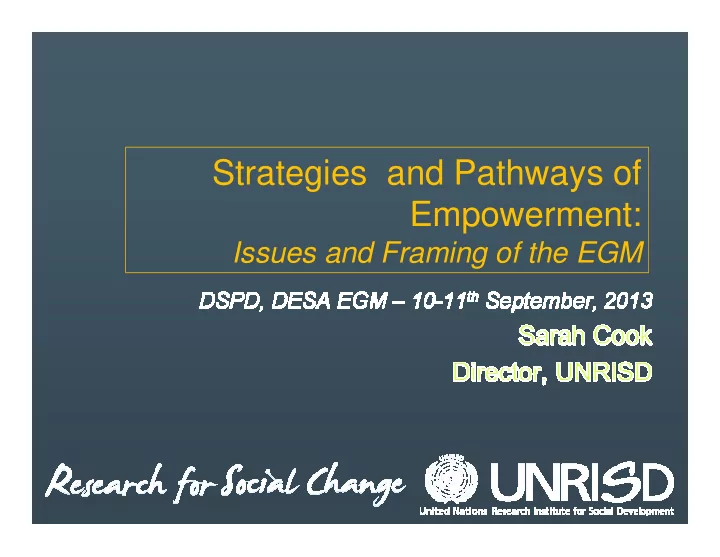

Strategies and Pathways of Empowerment: Issues and Framing of the EGM
Background and context • EGM (Sept. 2012) � • Priority theme of 51st session of Commission for Social Development (Feb. 2013): – Promoting the empowerment of people in achieving poverty eradication, social integration and full employment and decent work for all • EGM Sept. 2013 � – Concrete recommendations for presentation to Member States
EGM 2012 Definition • No one agreed definition • Empowerment as an iterative process requiring – An enabling environment • human rights, expanded choices, institutions, attitudes, values… – ‘empowered participation’ in decision-making • At local, national and global levels • Often mediated through civil society organisations – From group specific to holistic • Empowerment of women vs people-centred development? – Key elements: • agency, structure, behaviour, values
Outcomes? • Effective participation by members of society, as individuals and groups, in decisions about their lives, that is conditioned by a supportive enabling environment, and leads to the solution of economic and social problems confronting them • Outcomes – changes in behavior, social relations and institutions necessary for socially sustainable development… (concept note) • Indicators? Evidence?
Key points from CSocD 2013 High-Level Panel discussion on priority theme • Empowerment of people requires actions along multiple fronts, including: – political commitment; – common objectives; – inclusive policies that are coherent and integrated across sectors; – a strong, just and non-discriminatory legal framework; – appropriate institutional arrangements that facilitate civic engagement and broad-based participation; – aspiration and determination of vulnerable groups and individuals to improve their well-being.
Concrete measures to creating an environment conducive to people’s empowerment involve: • further strengthening of social policies to address specific needs of disadvantaged social groups; • adoption of people-centred development as a core objective of social and sustainable development; • formulation of policies and programmes to improve access and opportunities for all; • building or strengthening the institutions for participation and engagement of citizens to be more efficient, effective, transparent and accountable; • ensuring access to justice and legal instruments to reduce/eliminate poverty and inequality; • strengthening of human capacities though inclusive labour markets, social protection, education, health, and ICTs.
Issues & principles • Human rights, citizenship, non-discrimination • Institutions and policies, enabling environment • Knowledge and information • Ability to make claims, claim rights or entitlements • Access to justice, remedy, redress • Meaningful participation • Measurable outcomes and indicators
Expected outcomes of EGM? • Challenges, ‘good’ (bad) practices, lessons learned… • Concrete strategies, experiences in relation to empowerment of different social groups • Identification of (widely/universally applicable) empowerment strategies and indicators • Monitoring frameworks and social impact assessments • Implications for design / implementation of post 2015 goals • New issues / gaps for consideration, research • Recommendations
Structure Enabling Environment � overcome structures of Enabling Environment � overcome structures of constraints / change power relations constraints / change power relations Strategies and programmes Strategies and programmes Actors and Institutions Actors and Institutions Individuals state collective markets state househlds Resources, capabilities, opportunities… Resources, capabilities, opportunities…
Resources, capabilities, opportunities Individual capabilities / Collective capabilities / Policy and institutional resources resources framework
Strategies / interventions that work Individual Collective Policy Women and girls Youth Disabled Minorities Migrants Elderly
Reflections and challenges • Empowerment as a process of change –> what does it take to create (social, policy) change? – History, complexity, mobilisation, resources… – Context, political-economy, actors, relations – Agenda setting and claims-making: What issues get put on to agendas, who makes claims for what on behalf of whom (eg of care) – When and how do ‘policy moments’ arrive / how can they be made use of? – State / institutional capacities – services, frontline workers – Easy wins vs going the last mile
Key recommendations from SG Reports on promoting empowerment • Governments should establish or strengthen institutions that facilitate civic engagement and broad-based participation of all citizens and communities in the formulation, implementation and evaluation of socioeconomic policies; • Appropriate public sector policies should be adopted to encourage both public and private investment in social and economic infrastructure; • Universal access to basic social protection and social services is an important instrument for empowering people: Governments should consider establishing a national social protection floor consistent with national priorities and circumstances; • Strategies to empower women, youth, indigenous peoples, persons with disabilities, the elderly and other marginalized groups should be addressed in the mainstream development agenda; • Governments and their development partners should forge public-private partnerships ; • Educational systems and policies should provide adequate and practical opportunities to all, in particular young people;
Continued.. • Governments should promote the legal empowerment of the poor by ensuring pro-poor property rights and labour protections; • Successful empowerment strategies, including those targeting various social groups, must be created within — or adapted to — specific national or local contexts ; • Appropriate measures should be taken to broaden basic rights and to develop effective policy frameworks for empowerment through interventions and programmes that promote inclusive and participatory growth. • Enhanced efforts should be made to address the root causes of poverty, inequality and social exclusion, rather than the social consequences of economic or political processes, and the social drivers of structural change , in order to progress towards inclusive and sustainable development; • More concerted efforts are required to boost smallholder productivity; • In formulating the post-2015 development agenda , inequality, social inclusion, empowerment and participation, full and productive employment and decent work for all, and social protection should be given priority attention.
Recommend
More recommend